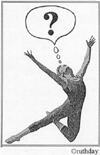| |
 |
How dancers and athletes
learn and remember
sequences of movement. |
|
|
|
|
How do people learn, remember, and perform sequences of movement? There are many ways to do so. For example, dancers can think about the names of the movements (e.g., "run-run-leap"), the counts (e.g., "1-and-2-3"), nonwords (e.g., "dee-dee-DAH"), the feeling of the movement, the basic rhythm, various visual images (e.g., of the teacher, themselves, or classmates performing the movement), or everyday images (e.g., "walking on hot sand").
Some dance forms are based on a well-defined set of body shapes and movements. For example, ballet has specific shapes such as "arabesque" and movements such as "tour jeté." Furthermore, nearly all of these shapes and movements have commonly accepted names. In contrast, modern dance has an infinity of possible shapes and movements and very few of them have accepted names (Day, 1999). This situation makes the task of learning movement sequences especially demanding in modern dance.
Memory for movement is required in many types of explicit movement domains, including dance, martial arts, and sports. It is also involved in everyday activities such as cooking, using software, and performing various jobs.
|
|
|
|
WHAT
| |
-- |
How dancers learn, remember, and perform dance |
| -- |
Basic cognitive processes involved (e.g., perception, attention, memory, representation) |
| -- |
Implications for dance (teaching, learning, creating, appreciating) |
| -- |
Extension to other movement domains (martial arts, aerobics, sports) |
| -- |
Implications for cognitive psychology |
WHO
| Dance students |
|
--American Dance Festival
--New York State School of the Arts
--Hollins University
--Duke University |
| Dance instructors |
|
--American Dance Festival faculty
--Instructors throughout the USA |
| Professional dance companies |
|
--Pilobolus
--Paul Taylor
--Merce Cunningham
--Eric Hawkins
--Bill T. Jones/Arnie Zane
--Alvin Ailey
--North Carolina Youth Tap Ensemble |
HOW
--Surveys
--Laboratory experiments
--Performed pieces |
--Class observation/analysis
--Structured interviews
--Reconstruction |
--Teacher workshops
--Student workshops
--Consulting |
TOPICS
| -- |
Memory cues and their effects on learning, memory, and performance |
| -- |
Memory load and how to cope with it |
| -- |
Linguistic codability of memory cues |
| -- |
Individual differences (companies, teachers, students) |
| -- |
The origins of memory errors (and how to cope with them) |
| -- |
Perception vs. memory vs. performance |
| -- |
"Feature theory" of dance |
| -- |
Beyond memory for movement (artistic expression, the dance experiencing) |
| -- |
Types of movement (modern dance, ballet, tap, ballroom, martial arts, aerobics, sports) |
|
|
|
|
Workshops
| Workshops for: |
|
--dance students
--dance instructors
--choreographers
--arts administrators
--archivists |
Consulting
| Informal consulting on memory problems/concerns of: |
|
--individual dancers
--instructors
--choreographers |
|
SAMPLE PAPERS / PRESENTATIONS
(on memory for movement) |
|
|
| Day, R. S. Memory for movement. American Dance Festival, 1991. |
| Day, R. S. Memory for movement. International Association for Dance Medicine |
| |
and Science, 1992. |
| Day, R. S. and Kee, A. N. Memory load cues in dance classes. Southeastern |
| |
Psychological Association, 1994. |
| Day, R. S. Overview of memory for movement: Project results. American Dance |
| |
Festival, 1997. |
| Day, R. S. Memory for movement: Implications for instructors. Dance |
| |
Professionals Workshop, American Dance Festival, 1998. |
| Day, R. S. From oral histories to the internet: Using ancient and contemporary |
| |
technologies to learn, teach, and preserve the art of the dance. New York State School of the Arts, National Museum of Dance, 1997. |
| Day, R. S. Memory for movement: Learning strategies. Hollins University, 1997. |
| Day, R. S. Memory for movement: Learning, teaching, and performing. New |
| |
York State School of the Arts, National Museum of Dance, 1998. |
| Day, R. S. Memory for movement: The Reconstruction Process. Dance Program, |
| |
Duke University, 1999. |
| Day, R. S. Memory for movement: Implications for instruction. Dance |
| |
Professionals Workshop, American Dance Festival, 1999. |
| Day, R. S. Memory for movement: Implications for instruction. Dance |
| |
Professionals Workshop, American Dance Festival, 2000. |
| Day, R. S. Memory for movement across the curriculum. American Dance |
| |
Festival, 2000. |
| Hines, K. Memory for movement: Duke professor studies steps to dance. |
| |
Duke Dialogue, 2001 |
|
|
